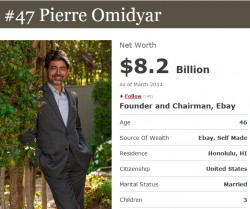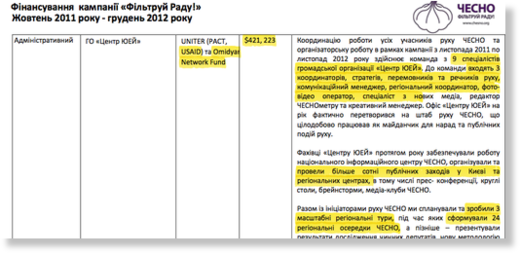Imperial Hubris: Ukraine as a ‘regime change’ too far for the American Empire
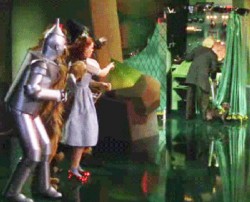
All anti-imperialists that have been secretly longing for the day when the last great Empire of our ‘modern’ era would finally do what all the ‘best’ Empires have done – overextend itself in both reach and hubris for all to see and usher in its collapse – should be looking at the situation in Ukraine with hope and expectation.
Well, maybe I’m getting a little carried away there, but the US-Ukraine-Russia debacle does seem to be presenting ‘we the people’ with a rare opportunity to see the great American Empire as the monolithic edifice, composed largely of lies, propaganda, rhetoric, fear and public credulity that it is. There is, perhaps, a chance to see that the emperor really is naked, and that our overblown overlords and their “greatest democracy on earth” exist and persist only because we all believe their carefully crafted lies served up to us in the yellow journalism of the Empire’s fourth estate, the mainstream media.
As the empire fades and the hubris of its leaders increases however, it seems even those carefully crafted lies aren’t having the desired effect. This week, both Obama and John Kerry exposed America’s vaunted ‘exceptionalism’ as being based on exceptional dishonesty when they made statements about Russian intervention in Ukraine. The funny thing is, both Obama and Kerry were actually trying to do the opposite – present themselves as paragons of righteousness. Apparently the Neocons from whom they take their orders failed to mention to these two spokesmen for Empire that ‘chutzpah’ should never be pushed too far, lest you expose your unmitigated effrontery and impudence for all the world to see.
In attempting to rally world public opinion behind him and against Russian President Putin, Kerry stated:
You just don’t in the 21st century behave in 19th century fashion by invading another country on completely trumped up pretext.
Emphasizing the point, he inadvisedly added:
You just don’t invade another country on a phony pretext in order to assert your interests.
Obama stated:
… any violation of Ukraine’s sovereignty and territorial integrity […] would represent a profound interference in matters that must be determined by the Ukrainian people. Throughout this crisis we have been very clear about one fundamental principle, the Ukrainian people deserve the opportunity to determine their own future […] human beings have a universal right to determine their own future.
I probably don’t need to go into too much detail about why, on the basis of these statements alone, the Nobel Committee should invent a new category called ‘most hypocritical statement by a politician in the history of the world‘ and immediately present it jointly to Kerry and Obama, so I’ll just throw out a few country names: Iraq, Afghanistan, Libya, Syria. On Iraq, Kerry voted for the 2003 US military invasion on completely trumped up charges about non-existent WMDs that were used as a phony pretext so that people like Kerry could ‘assert their interests’. 1.5 million Iraqi civilians died as a result and today the country is in ruins and plagued by bombings and assassinations. Kerry went on to defend his vote during his run for president in 2004 against Bush. Obama authorized the March 2011 NATO bombing of Libya without congressional approval on completely trumped up charges of “protecting civilians” and justified by “right to protect” that completely denied the Libyan people their purported ‘universal right to determine their own future’. The bombing ultimately caused the deaths of 40,000 Libyan civilians and installed a fundamentalist Islamic government.
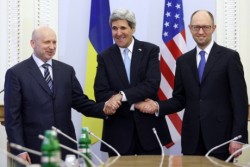
It’s also worth noting that, just a few weeks previous to Obama and Kerry’s statements on Ukraine, a plot was being hatched behind the scenes between US Asst. Sec. of State, Victoria Nuland and the U.S. Ambassador to Ukraine, Geoffrey Pyatt. Note that Nuland’s husband is Council on Foreign Relations member, PNAC founder and senior fellow at the Brookings Institution, Robert Kagan. The Brookings Institution is one of Washington’s oldest “think tanks” and ranked “the most influential think tank in the world” which means that it is the source of most of the US government’s policies on “strengthening American democracy and securing a more open, safe, prosperous, and cooperative international system“, which is a covert way of saying, ‘how to make the world safer for American corporate and banking interests’.
The key points of Nuland and Pyatt’s conversation make it very clear that the US State Dept. was under orders to choose a new Ukrainian Prime Minister without consulting the Ukrainian people:
Nuland: So I don’t think Klits should go into the government, I don’t think it’s necessary, I don’t think it’s a good idea. […] I think Yatz is the guy who’s got the economic experience, the governing experience, what he needs is Klits and Tyahnybok on the outside, he needs to be talking to them four times a week, I just think going in, he’s gonna be at that level working for Yatzenyuk, it’s not gonna work […]
so I think you reaching out directly to him helps with the personality management among the three and it gives you also a chance to move fast on all this stuff and put us behind it before they all sit down and he explains why he doesn’t like it.
He’s now gotten both Serry and Ban Ki-moon to agree that Serry could come in Monday or Tuesday. So that would be great, I think, to help glue this thing and to have the UN help glue it and, you know, Fuck the EU.
Pyatt: No, exactly. And I think we’ve got to do something to make it stick together
But anyway we could land jelly side up on this one if we move fast. So let me work on Klitschko and if you can just keep… we want to try to get somebody with an international personality to come out here and help to midwife this thing.
Nuland: Biden and I said probably tomorrow for an atta-boy and to get the deets [details] to stick. So Biden’s willing.
And yet, both Kerry and Obama have the audacity to feign concern for Ukraine’s ‘independence’.
US-sponsored ‘Revolutions’ and ‘Civil Wars’
There are several likely rationales behind US and EU interest in bringing Ukraine into the fold, so to speak, but underpinning them all is the desire of the psychopaths in power and their associated world banking cartels to accrue ever more control and wealth to themselves.
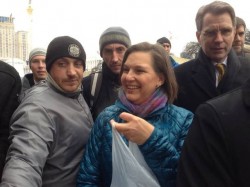
In case you haven’t been watching events on the planet over the past 70 years, it’s ‘what they do’. Greed is a sickness which, when facilitated by almost unlimited means to pursue it, becomes an end in itself. There is no valid ideal or ‘common good’ that is served by the greed of our psychopaths in power, despite the narratives they may tell themselves and the public. If a man owns half the world and couldn’t possibly, in his own lifetime, ‘enjoy’ or experience all of his possession, why would he attempt to own the other half? If the ‘elite’ of this world have, by manipulation, blackmail, bribery and threats brought most of the world’s countries and their populations under their control, why bother with the one or two that are left that refuse to comply? It’s pointless looking for a rational answer to this question because the greed that drives such creatures is quite literally a form of insanity, at least from the perspective of normal human nature and what motivates it.
There’s something everyone should know about revolutions. Historically, violent revolutions, especially those in which Western powers have an interest, are organised and controlled by a very small cadre of extremists who ultimately do not represent the interests of either the majority of protestors or the people of the country in question. This was true of the Bolshevik revolution in 1917 where Lenin and Trotsky, funded by New York banking and corporate interests, had, at most, about 10,000 supporters in a country of some 120 million people. It is also true of most of the ‘Arab Spring’ revolts, and of course, Syria, where Western-backed and armed ‘al-qaeda’ rebels have been attempting to impose a fundie Muslim regime on a multi-ethnic, multi-religious Syrian people who have enjoyed a largely secular government under Bashar al-Assad.
Based on the available data, the most recent plan to remake Ukraine in the likeness of other client nations of the Empire – financially controlled by the IMF and geopolitically controlled by NATO – involved a formula that has been tried and tested many times in many other countries. From Guatemala in the 1950s to Syria in 2011, the regime changers in Washington have, in most cases, preferred ‘destabilization’ and ‘revolution’ over a ‘boots on the ground’ invasion. The latter can be very messy, what with all the deaths of American soldiers making the war unpopular with the people back home, not to mention the task of coming up with a trumped up ‘causus belli’. The former, ‘destabilization’, is preferred because it involves a covert war against a sovereign nation that seeks to provoke and inflame underlying ‘fracture points’ within the population to effect the destabilization and ‘regime change’. These ‘fracture points’ are any ethnic, religious, class or other ideological divisions, however insignificant, that exist within the host population and a detailed analysis of them is carried out as part of the preliminary planning of the ‘revolutionary coup’.
In Ukraine, it appears that the chosen ‘fracture point’ was the really obvious one: Ukraine’s Soviet era history and the ‘division’ between its ‘nationalist’ Ukrainian population living mostly in the West of the country and the millions of ethnic Russians that live mostly in the South and East.
The 2004 Color Revolution
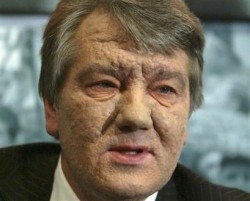
Victor Yushchenko’s ‘Our Ukraine bloc’ aligned with Tymoshenko’s bloc played a major role in the US-funded ‘Orange Revolution’ in 2004 that gave him (Yushchenko) the Presidency of Ukraine from 2005-2010. Yushchenko made Tymoshenko his Prime Minister but within a year infighting between the two led to Yushchenko dismissing Tymoshenko and criticizing “her work as head of the Cabinet, suggesting it had led to an economic slowdown and political conflicts within the ruling coalition”. Tymoshenko and Yushchenko kissed and made up in 2007 and she was again appointed Prime Minister, but the events of her previous time in office replayed with president Yushchenko strongly criticizing the economic policies of her government. Both Tymoshenko and Yushchenko ran for President in 2010 but both lost out to recently ‘deposed-in-a-popular-revolution’ Victor Yanukovych. By the time of the 2012 Ukrainian parliamentary elections, Tymoshenko had been imprisoned and Mr. ‘Orange Revolution’ Yushchenko, who headed the election list of the ‘Our Ukraine’ party, had fallen out of favor with the Ukrainian people to the extent that his party won just 1.11% of the national votes and no constituencies and thus failed to win parliamentary representation.
The Orange Revolution was built on a pattern first developed in the ousting of Slobodan Milošević in Serbia four years earlier, after NATO had incited civil war and bombed the former Yugoslavia to pieces, and continuing with the Rose Revolution in Georgia. Each of these victories, though apparently spontaneous, was the result of extensive grassroots campaigning and coalition-building among the opposition. Each included election victories of candidates of which the US government did not approve, followed by public demonstrations after allegations of electoral fraud by NGOs that were funded by the American government.
Activists in these movements in Ukraine’s ‘Orange Revolution’ were funded and trained in tactics of political organisation and nonviolent resistance by a coalition of Western pollsters and professional consultants who were funded by a range of Western government and non-government agencies. At the same time, the 2004 ‘Orange Revolution’ featured the very same armor-clad anarchists that we have seen in recent weeks in Kiev. According to The Guardian, the foreign donors included the U.S. State Department and USAID along with the National Democratic Institute for International Affairs, the International Republican Institute, the NGO Freedom House and George Soros’s Open Society Institute. The National Endowment for Democracy (NED), used extensively by the CIA as a front, supported by the U.S. government has supported non-governmental democracy-building efforts in Ukraine since 1988.
Last year, NED President Carl Gershman said “Ukraine is the biggest prize”.
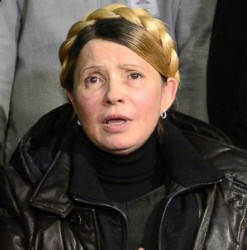
In a general sense, there are two dominant political ideologies in Ukraine represented by a pro-Russian party and a pro-Ukraine/USA/EU/NATO party (there’s an oxymoron if I ever saw one!). The pro-Russian party is the ‘Party of Regions’ (led until January this year by Mykola Azarov, when he resigned because of the protests), which won the largest share of the vote and seats in the last parliamentary elections (34.4%, 175 seats). Recently ‘deposed-in-a-popular-revolution’ Victor Yanukovych has also served time as the leader of the Party of Regions.
In the other corner is the pro-Ukraine/USA/EU/NATO party, the ‘Fatherland Party’, led by the previously mentioned Princess Leia lookalike and recently released from prison, corrupt gas-stealing oligarch, Yulia Tymoshenko. The Fatherland party won 30.7% of the vote and 156 seats in the 2012 election.
At election time, the majority of Ukrainian people generally throw their lot in with one or other of these factions, but as we have seen, over the last 8-10 years, neither of these parties/factions can be said to have done well by the estimation of the Ukrainian people, with wages, jobs and health care all not being exactly up to snuff. Of course, since the IMF and Western ‘interests’ have been involved in Ukraine from the very beginning, a dodgy economy isn’t exactly surprising since those influences tend to encourage the creation of a rich upper class and a not-so-rich rest of the population. With the ‘Orange Revolution’ having failed to live up to the promises of its leaders, and its leaders Yushenko and Tymoshenko preferring to battle it out for the title of greediest oligarch, the IMF and those Western interests weren’t happy, least of all about the pesky pro-Russian element. By 2009-10, the Ukrainian people themselves were suffering and had had enough, as the BBC reported at the time of the last presidential elections in 2010:
“The financial crisis has hit Ukraine hard. Some banks have collapsed and it is not uncommon to see people queuing up outside their branches in the hope of compensation.”
What most people worry about here are not rather abstract notions of relations with Moscow or membership of NATO. Their main concern is the economy. And for many, in the past five years, things have got worse, not better.
“We were hoping that at last we would be independent,” said one woman in her mid-60s wearing a headscarf, standing in line outside a bank.
“Finally we thought we would get closer to Europe, to the standards of living there. But it turned out to be nothing but lies.”
IMF involvement in Ukraine
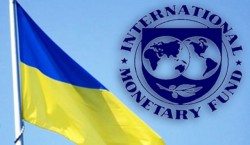
The reason why Ukraine is not yet “independent”, and probably never will be in the current global conditions, is that, contrary to Washington’s portrayal of Muscovite interference, the Washington-based IMF has been deeply involved in running Ukraine into the ground long before this current crisis came to the fore. In the Western media narrative, the IMF and EU are poised to become savior-guardians of Ukraine, if they can only prise it from Russia’s death grip. The historical reality they conveniently forget is that Ukraine joined the IMF in 1992 and began to borrow money from the Western cartels, loans that of course come with ‘structural conditionalities’, policy-speak for what author Naomi Klein aptly termed ‘economic shock therapy‘.
Ukraine, like all the others before and since, was savaged as it fell deeper and deeper into debt and its natural resources were plundered. Its population has not yet recovered from the trauma and it is this trauma that has provoked protests to this day. As Natalia Vitrenko, economist and leader of the Progressive Socialist Party of Ukraine explains in the following report:
“The IMF came in with dollars and bought off politicians, officials, and members of Parliament. Ukraine started doing everything the IMF said to do: deregulation, privatization, and macroeconomic stabilization according to neo-liberal economic theory. What did deregulation mean? It meant a floating currency exchange rate, while all the state-owned and commercial banks were cut loose to fend for themselves.
Then came privatization, in which, essentially, the whole economy was put on the auction block for peanuts: the collective farms, industry, and so forth. In macroeconomic terms, Ukraine shifted to a cheap-labor model, with the reduction of social benefits and elimination of subsidies for housing and utilities.”
Once Ukraine was prised open, it was exposed to the most rampant forms of predatory ‘neo-liberal economic theory’. All it has gained is a handful of oligarchs and a mountain of debt. Out of 50,000 state companies that were privatized, half no longer exist, resulting in the loss of 12 million jobs. In 1992, Ukraine accounted for 2% of world GDP. Now it accounts for just 0.2%. 80% of its population now lives below the poverty line, and life expectancy has dropped to 15 years behind European averages. You get a real idea of the scale of the IMF’s handiwork in Ukraine when you consider that its population was 52.1 million people in 1990. In 2012 it was 45.6 million, and 7 million of those work in Russia. Based on its 1970-1990 growth rate, Ukraine’s population should today be 57 million. Thus, it can be argued, the IMF is responsible for the death of up to one third of Ukraine’s population these last two decades.
What else can we call this but economic genocide and war by other means?
In this context, with his or her hands tied by the weight of ever-increasing indebtedness to the Western banking cartel, what could the ousted Yanukovych or any other Ukrainian leader really have done to improve the people’s lot? This is why, in August last year, Yanukovych rejected the latest IMF/EU deal and looked to Russia for a better one. Yet, as far as the West is concerned, it already owns Ukraine. In its psychopathic mindset, EU and NATO memberships are just formalities at this point, and the recent contrived ‘revolution’ was their attempt to ‘call in the debt’.
Funding Ukraine’s neo-Nazi Sektor and Chechnyan ‘Jihadis’
After the break up of the Soviet Union, new political organisations based on right-wing Ukrainian nationalism and ‘anti-Communism’ sprang up. The most notable of these (at least in elections) is Svoboda. Founded in 1991 as the Social-National Party of Ukraine (SNPU), a direct reference to Nazism, and registered as a political party in 1995, the SNPU’s official program defined itself as an “irreconcilable enemy of Communist ideology” and all other parties to be either collaborators or enemies of the Ukrainian revolution. The SNPU changed its name to the All-Ukrainian Union Svoboda in February 2004 with the appointment of Oleh Tyahnybok as it’s leader.

Since its creation, and to this day, Svoboda is described as far-right, fascistic and anti-semitic. The party achieved some electoral success in local elections and Tyahnybok managed to get elected to the Ukrainian parliament in 1998. Tyahnybok subsequently lost his seat and managed re-election in 2002 only because he was a member of Victor Yushchenko’s ‘Our Ukraine’ bloc, a grouping of small pro-Western pro NATO political parties that alone would not have been effective in getting their message across.
Tyahnybok has given speeches in the past deriding “kikes” and in 2005 wrote a letter to the president calling for an investigation into “organised Jewry and criminality in Ukraine“. Svoboda is part of an alliance of European neo-fascists, the Alliance of European National Movements, which includes France’s National Front, the British National Party and Hungary’s Jobbik.
The general feeling of most Ukrainians to Tyahnybok’s party and policies was, however, revealed during his candidacy in the 2010 presidential election when he received 1.43% of the vote.
Strangely enough though, in the new illegitimate ‘interim’ government of puppet Arseniy Yatsenyuk, Svoboda was given six major cabinet ministries although Tyahnybok himself did not receive a portfolio.
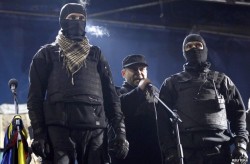
The other prominent nationalist, fascist, ‘anti-semitic’ organisation in Ukraine with ties to Svoboda is the Ukrainian National Assembly – Ukrainian National Self Defence (UNA-UNSO). Formed in 1990 on an anti-Communist manifesto they have also received very little support from the Ukrainian people at the polls. The party maintains a close relationship with the National Democratic Party of Germany which is considered to be a promoter of a neo-Nazi ideology.
When looking at their origins and manifestos, the general impression that these fascist anti-Russian groups create is that they are stuck in the past. They were formed in the early 1990s as a reaction against any potential influence from the former Soviet Union and, since then, have failed to recognise that modern day Russia is not the Soviet Union. Their numbers appear to be drawn from pathological types who gravitate towards extremist ideologies based on ethnicity and culture. Both of these factors made this particular marginal segment of Ukrainian society the ideal choice for Western influences to work their ‘revolution’ magic.
Right Sector is a group you’ve probably heard about as leading the extreme violence at the ‘Maidan’ protests. Right Sector first emerged at the end of November 2013 and is closely associated with both Svoboda and UNA-UNSO, from which it draws its members, which are said, by the group itself, to number between 2,000-3,000 in Kiev. The leader of Right Sector is Dmytro Yarosh. On March 1, 2014, Yarosh appealed to Dokka Umarov, a Chechen militant guerrilla leader associated with ‘al-Qaeda’, for support of Ukraine:
“Ukrainian nation and nations of [Northern] Caucasus region have been united by mutual bloodshed. Many Ukrainians supported a freedom fight of Chechen and other Caucasian nations with guns in their hands. Now is the time to support Ukraine!
As the leader of the ‘Right Sector’, I beg you to intensify your fight. Russia is not as strong as it seems. You have a unique chance to win. Take it!“
Russia has waged campaigns in 2000 and 2008 against Islamic ‘separatists’ in the Northern Caucus regions of Russia who have been blamed for several bomb attacks in Russia including the 1999 Russian apartment bombings that killed 293 people, the Moscow theater hostage crisis of 2002 that left 133 hostages dead, and the 2010 Moscow Metro bomb attack that killed 40 people.

Chechen ‘rebels’ like Yarosh’s friend Dokka Umarov, who calls himself “Russia’s bin-Laden”, spout the same nonsense as other ‘Jihadis’ about wanting to establish an ‘Islamic caliphate’ with Sharia law, etc. Evidence suggests however that the ‘rebels’ from Chechnya and other potential breakaway areas of Southern Russia have for many years been funded by various US and European NGOs. The Kavkaz Center, for example, is a a “Chechen internet agency which is independent, international and Islamic”. It is banned in Russia and on the United States’ List of Most Wanted Terrorist Organizations, yet it has received funding from both the US State Department and Finland’s Foreign Ministry.
In 2009, Reuters quoted the head of the Russia’s Chechen Republic as saying:
“We’re fighting in the mountains with the American and English intelligence agencies. They are fighting not against Kadyrov, not against traditional Islam, they are fighting against the sovereign Russian state.”
The West sought to attack both Russian Prime Minister Vladimir Putin and the country as a whole by targeting the country’s weakest regions.
“The West is interested in cutting off the Caucasus from Russia. The Caucasus – a strategic frontier of Russia. If they take away the Caucasus from Russia, it’s like taking away half of Russia.”
Asked if he was saying there were signs of CIA and MI6 participation in the violence, he said “Of course, there was a terrorist Chitigov, he worked for the CIA. He had U.S. citizenship… When we killed him, I was in charge of the operation and we found a U.S. driving license and all the other documents were also American.”
In September 2004 the Kavkaz Center published a letter from the Chechen rebel commander Shamil Basayev claiming responsibility for the Beslan school hostage massacre and a series of photos from the preparations for the attack. 380 Russian civilians died in the massacre, including 186 school children. Basayev was also responsible for the 2002 Moscow theater hostage crisis. Abdul-Halim Sadulayev was a former President of the unrecognized ‘Chechen Republic of Ichkeria’. Basayev was Sadulayev’s second-in-command. Akhmed Zakayev was appointed culture minister in Sadulayev’s government. Zakayev was accused by Russia in 2002, while in Denmark, of involvement in planning the Moscow theater hostage massacre. He is also a good friend of now-deceased anti-Putin Russian oligarch-in-exile (in the UK) Boris Berezovsky. You may remember that Boris
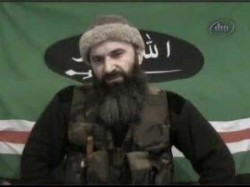
Berezovsky was a Russian Jewish billionaire who was head of Russian National Security under Boris Yeltsin. When Putin came to power he opened investigations into Berezovsky’s business activities, including money laundering. Berezovsky responded by fleeing to the UK where he was granted political asylum and from where he launched a vocal campaign against Putin. Berezovsky also held Israeli citizenship. Berezovksy was a close friend of Alexander Litvinenko, the Russian dissident who was murdered by polonium poisoning in 2006 in London. At the time, the Western media pointed the finger of blame at Putin, although the evidence suggests otherwise. Berezovksy also financed Yushchenko’s ‘Orange Revolution’, despite the fact that financing of election campaigns by foreign citizens is illegal in Ukraine.
Looked at in isolation, the Kavkaz Center may appear insignificant, but when considered in the context of the plethora of other so-called ‘NGOs’ that have been operating for many years in support of anti-Russian Chechen and other Caucasian ‘rebels’, and combined with the 20-year Western government and media campaign to discredit, neutralize and ultimately dissolve the Russian Federation, we begin to see something much more insidious, as Eric Draitser of ‘Stop Imperialism’ states:
It is the association of these types of individuals and organizations with the US State Department and US intelligence that makes them particularly insidious. One such entity that bears scrutiny is the American Committee for Peace in the Caucasus (ACPC), previously known as the American Committee for Peace in Chechnya. As reported by Right Web at the Institute for Policy Studies, “The ACPC was founded in 1999 by Freedom House, a neoconservative organization that has worked closely with the U.S. government, receiving funds from the National Endowment for Democracy and other U.S. democratization initiatives.” This intimate relationship between the ACPC and the US State Department indicates not merely a confluence of interests, but rather a direct relationship wherein the former is an organ of the latter.
On November 23rd 2013, the Kavkaz Center reported on a statement by Yarosh that threatened violent overthrow of the Ukrainian government and ended with:
Death to the regime of internal occupation!
Glory to National Revolution!
Glory to Ukraine!
US Government and Corporate Funding of Ukrainian ‘NGOs’
When pro-Russian Yanukovych was reelected President in 2010, the ‘seat of power’ in Ukraine swung back towards Russia. On taking up the post Yanukovych said:
“Ukraine’s integration with the EU remains our strategic aim, with a “balanced policy, which will protect our national interests both on our eastern border – I mean with Russia – and of course with the European Union”. Ukraine must be a Neutral state which should be part of a collective defence system which the European Union, NATO and Russia will take part in.”
Yanukovych said that Ukraine should “neither join NATO nor the CSTO (Russia’s NATO equivalent) and that the current level of Ukraine’s cooperation with NATO was sufficient and that the question of the country’s accession to the alliance was therefore not urgent. Since independence, every poll in Ukraine has shown a majority against NATO membership, yet one after another the elites who ran the country until 2010 and who are now back in charge ignored the popular will in that regard (and many others). Seduced by NATO’s largesse and the feeling of being part of a hi-tech global club, they took part in joint military exercises and even sent Ukrainian troops to Iraq and Afghanistan. The ONLY Ukrainian leader who rebuffed NATO and the EU was the recently ousted Yanukovych.
But all was not lost for the regime changers in the IMF and Washington and they saw the opportunity for a real shake up of Ukrainian political scene via those tried and tested methods. What was needed to get those already disgruntled citizens in their resource rich country even more agitated was a little rumor-mongering about election rigging around the 2012 Parliamentary elections.
As noted, Yanukovych’s pro-Russian Party of Regions won the most votes in the 2012 Parliamentary elections giving it the right to form a government. The election results however were marred with allegations of vote buying and rigging, and the main organisation promoting those allegations was ‘Chesno‘ (‘Honestly’ in Ukrainian), a public organization that aims to “advance a fair election process“. Chesno appeared suddenly in late 2011 and is allegedly headed by a “group of interested activists along with representatives of the partnership New Citizen”.
Civil movement Chesno stated on 5 December 2012 that 331 out of the 450 deputies elected on 28 October fell short of its criteria for honesty; according to “Chesno”‘s parameters, 114 of them violated the rights and freedoms of citizens, 30 earlier changed their political position while working in parliament or on local councils, 233 had been involved in corrupt practices, 185 had nontransparent incomes and expenses, 156 did not personally take part in voting in previous parliaments, and 101 had shirked work in parliament.
Now, a little test. Guess where Chesno gets its funding? If you said ‘the USA’, you’re absolutely right, specifically from USAID or the United States Agency for International Development, an outfit that even Wikipedia knows is a front for CIA activities. But it gets worse, the document showing Chesno’s funding also cites something called the Omidyar Network Fund. Turns out ‘Omidyar’ is none other than Pierre Morad Omidyar the French-born Iranian American entrepreneur and philanthropist, who is the founder and chairman of the eBay auction site. Omidyar’s ‘Omidyar Network’ that funded Chesno along with USAID is (according to him):
“… a philanthropic investment firm dedicated to harnessing the power of markets to create opportunity for people to improve their lives. Established in 2004 by eBay, founder Pierre Omidyar and his wife, Pam. The organization invests in and helps scale innovative organizations to catalyze economic, social, and political change. To date, Omidyar Network has committed more than $270 million to for-profit companies and nonprofit organizations that foster economic advancement and encourage individual participation across multiple investment areas, including property rights, government transparency, and social media.”
Does Ukraine have an eBay site? Don’t think so, but it soon might, to go along with a crippling IMF loan.
In 2011, Omidyar Network publicly admitted that it also gave $335,000 to the above mentioned New Citizen, (aka Center UA) which is chaired by Oleh Rybachuk. Who the hell is Oleh Rybachuk? He’s a Ukrainian former banker and politician and former Chief of Staff to Mr. Orange Revolution former Ukrainian President Victor Yushchenko. Rybachuk is also a major shill for NATO. In 2006 he spoke at a NATO forum and said:
“The task of political forces [in Ukraine] is to compromise on when Ukraine will sign a NATO Membership Plan” […] Mr. Rybachuk said Ukraine’s leaders must now join their efforts to launch an information campaign promoting the country’s Euro-Atlantic integration, so that Ukrainians freely and consciously choose their future.
Did ya get that? That’s Democracy in action right there: “launch an information campaign” so that “Ukrainians freely and consciously choose”. Sounds like Obama and Kerry.
In 2004 he spoke at the American Enterprise Institute (AEI) where he shared the floor with Zbigniew Brzezinski. The AEI is:
… a conservative American think tank founded in 1938. Its stated mission is “to defend the principles and improve the institutions of American freedom and democratic capitalism – limited government, private enterprise, individual liberty and responsibility, vigilant and effective defense and foreign policies, political accountability, and open debate.
Also in 2004 Rybachuk had a chat with then US Deputy Secretary of State Richard Armitage, no doubt the topic of conversation was the ‘Orange Revolution’ and how the USA could ‘help’.
I hope you’re starting to get the picture here. After the 2010 victory of ousted President Yanukovych and after the 2012 parliamentary victory of Yanukovych’s pro-Russia Party of the Regions, the scene was being set for a “popular revolt” that would provide justification for the overthrow of the pro-Russian government and president and the installation of something a little more compliant to Western ‘interests’.
Interestingly, in early November 2011, Yankukovych made a statement that was derided as ‘paranoid’ at the time but has since shown to be rather prophetic; he claimed that Kyiv would soon plunge into violence, with armed attacks on government agencies as his opponents attempt a coup to destabilize the nation.
About That Ukraine-EU Agreement
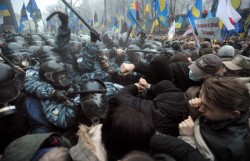
Nothing pleases the elite more than watching normal humans fight with each other.
Despite the way that the Western media has portrayed the Kiev square protests, with repeated references to Yanukovych’s lavish ‘palace’, etc., they were not purely ‘anti-Yanukovych’ and not united in their Russo-phobia. No Ukrainian at any protest was under any illusion that by removing Yanukovych all (or any) of their complaints would be addressed. As I have pointed out, the Ukrainian people have been trapped for years between dueling oligarchs, either of the pro-NATO or pro-Russian variety. The suggestion that the protestors were angry that the Yanukovych government had backtracked on the proposed Ukraine – European Union Association Agreement (AA) in November 2013 in favor of a Russian agreement is only partly true. For many Ukrainians, the EU agreement was seen as first step towards attaining the ‘standard of living’ of Western Europeans, hence, their major beef was the state of the Ukrainian economy and the corruption of their leaders and aligning with the EU was viewed as a means to an end. Sadly, most Ukrainians are unaware that they would in fact be much worse off if their government signed the AA, and this was precisely why the Yanukovych government decided to back away from the deal
The AA was actually initialed in 2012 in Brussels, but European Union High Representative for Foreign Affairs Catherine Ashton made ratification of it contingent on the release of Tymoshenko. Throughout 2013 the EU continued to insist on the pre-condition of the release of Tymoshenko and that Ukraine meet EU standards in “rule of law, independence of the judiciary, selective justice, politically motivated justice, free and fair elections, comprehensive constitutional reform”. This put the Yanukovych government in a difficult position, not only because of the mammoth task involved in meeting the EU requirements, but also because Russia had begun to point out some ‘home truths’ to Ukraine including the obvious consequences of Ukraine signing the AA.
Putin’s top economic advisor, Sergey Glazyev, stated that the impact of Russia’s response to Ukraine signing the agreement with the EU, including tariffs and trade checks, could lead to default, a decline in the standard of living and “political and social unrest” in Ukraine, and would violate the Russian-Ukrainian strategic partnership and friendship treaty. Putin warned that members of the Customs Union of Belarus, Kazakhstan and Russia may impose what he called protective measures in the event of trade liberalization between Ukraine and the EU. On October 8th Putin stated that, if the AA was signed by Ukraine, Russia would not close its market to Ukrainian products, but there would be no more benefits and that “Ukrainian goods will be in the same position as goods from other countries of the world that are WTO members”.

During this time President Yanukovych and his government sought in vain to appease both sides. At the opening session of the Ukrainian parliament in September 2013, Yanukovych urged his parliament to adopt laws so that Ukraine would meet the EU criteria and sign the Association Agreement in November 2013. On November 21st however, the Parliament failed to pass any of the six motions on the release from prison of former Prime Minister Yulia Tymoshenko, which was an EU demand for signing the association agreement. Of course, one wonders why the EU, in particular Germany, was so insistent on Tymoshenko’s release.
In the end, Yanukovych abandoned plans to sign the agreement due to the combination of a harsh IMF loan that was part of the agreement, Russian reminders of the financial consequences of aligning economically with Europe, and the failure of the EU to do anything to compensate Ukraine for these losses. On Nov. 21st, 2013, Prime Minister Mykola Azarov said that the decision was taken in order to “ensure the national security of Ukraine” after taking into account the effects of trade with Russia if the agreement was signed. He told opposition lawmakers the next day that his government’s decision to walk away from the agreement was based on fiscal imperatives, and ultimately prompted by the International Monetary Fund’s overly harsh terms for an aid package.
On November 26th, Prime Minister Azarov stated: “I affirm with full authority that the negotiating process over the Association Agreement is continuing, and the work on moving our country closer to European standards is not stopping for a single day”. President Yanukovych still attended the 28-29 November EU summit in Vilnius, but the Association Agreement was not signed.
During the summit, Yanukovych stated that Ukraine still wanted to sign the Association Agreement but that it needed substantial financial aid to compensate it for the threatened response from Russia, and he proposed starting three-way talks between Russia, Ukraine, and the EU. He also urged Brussels to help Ukraine soften the terms of a possible loan from the IMF. The EU rejected trilateral talks and asked Yanukovich to commit to sign the Association Agreement, which he refused to do.
In response to these events, Tymoshenko issued a statement from her jail cell urging people “to react to this as they would to a coup d’état” and take to the streets, yet there were no mass protests at this point.
With the plans for IMF/EU economic ‘shock therapy’ via the diplomatic route scuppered due to EU and IMF greed and fecklessness and Russia digging its heals in, the attention of the US government’s NGOs turned to plan B and those right-wing fascist types. The ‘people’s revolution’ was to be radicalized and chaos unleashed onto the streets of Kiev. But the end goal may not simply have been a coup in Ukraine but the baiting of Russia into war.
Equal Opportunity Snipers Without Borders
During the initial protests in Kiev that we are told involved hundreds of thousands of people (at least once), participants in the Ukrainian ‘revolution’ quickly dwindled as the nature of the protests turned more violent. What is clear is that, from early on in the ‘revolution’, there were no more than a few thousand people centered on Independence Square in Kiev (the Maidan), and among them no more than a few hundred, apparently well trained and extremely violent ‘protestors’ from, we assume, the Right Sector and assorted Ukrainian (and perhaps foreign) neo-nazi groups.
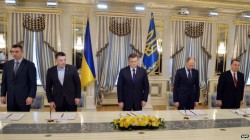
The ‘peace deal’ that never was: Yanukovych, ‘Yatz’ Tyahnybok, Klitschko etc. looking none too happy
The Ukrainian Prime Minister had resigned on January 28th in a failed attempt to appease protestors. As the violence and attacks on police intensified, by February 18th President Yanukovych was in negotiations to draft a ‘peace deal’ with three members of the opposition that had been selected (see phone call above) by US Asst. Sec. of State Victoria Nuland and her Ukrainian Ambassador Pyatt – Yatzenyuk, the fascist Tyahnybok and Klitschko along with French, German and Polish Foreign Ministers. The agreement called for a drastic reduction in Yanukovych’s presidential powers, a return to the 2004 constitution, the release of Tymoshenko from prison, early elections for later this year, the appointment of Yatzenyuk as Prime Minister and Klitschko as deputy Prime Minister and the dismissal of the current government.
This should have been (and probably was) enough to calm the real protestors and allow them to take a ‘wait and see’ approach, because after all, the leaders of the opposition who had signed the agreement were in charge of the protestors on the streets of Kiev, right? However, as the negotiations were ongoing, someone began a shooting spree in the streets around Kiev square over the three days of February 18th-20th. At least 15 policemen and 80 protestors and civilian bystanders were shot dead by what appears to have been a team of snipers firing from the tops and windows of buildings. The agreement was signed by Yanukovych on the 21st, but the large death toll appears to have contributed to the, almost immediate, scrapping of the agreement and the announcement by Ukraine’s new leaders that Yanukovych would be impeached.
The new pro-EU/NATO economist pencil-pusher ‘interim’ Prime Minister Yatzenyuk declared that he and his ‘opposition’ comrades had “lost control” of the protests (if they ever had it). Clearly the actual leaders of the ‘Maidan’ had an agenda that went much further than simply forcing the government to agree to protestors’ demands for a ‘change of government’.
Those who were watching the protests closely as they unfolded day by day will perhaps remember the remarkable scenes of well-trained, small groups of body-armored men with sticks and clubs beating policemen with apparent impunity and meeting with very little resistance. There was also shocking video footage of police forces repeatedly being engulfed in flames and powerless to do anything to stop the petrol bombers. ‘Protestors’ also were seen firing guns at police and sniping at them from hotel windows. Then there is this BBC report where, after showing live footage of protestors being gunned down by unknown snipers (although the BBC reporter portrays them as ‘government snipers’), at the 2 minute, 40 second mark, the same BBC reporter states that a shot had come from a hotel opposite their position, from their own hotel in fact, and that he “saw the shooter, he was wearing one of the protestor’s green helmets”.
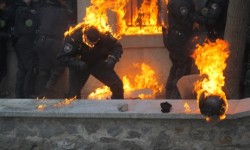 That so many people died in Kiev during the third week of February is undoubtedly a tragedy, and the ‘opposition’ certainly took full advantage of the deaths. Without the bloodshed it is unlikely that the Right Sector and their foreign backers would have been able to force the trashing of the agreement and force the impeachment vote on Yanukovych. Yanukovych, or someone in his government, has been accused of ordering government security forces to open fire on the protestors. It appears to be true that permission was given to Kiev police to use lethal force in response to gunfire from … someone, but the order was given on Feb. 20th, two days after the shooting started. Mystery still surrounds the identity of the snipers that shot at least 15 people in this video.
That so many people died in Kiev during the third week of February is undoubtedly a tragedy, and the ‘opposition’ certainly took full advantage of the deaths. Without the bloodshed it is unlikely that the Right Sector and their foreign backers would have been able to force the trashing of the agreement and force the impeachment vote on Yanukovych. Yanukovych, or someone in his government, has been accused of ordering government security forces to open fire on the protestors. It appears to be true that permission was given to Kiev police to use lethal force in response to gunfire from … someone, but the order was given on Feb. 20th, two days after the shooting started. Mystery still surrounds the identity of the snipers that shot at least 15 people in this video.
In a recent press conference, Putin responded to a reporter’s question about the shootings by stating that Yanukovych told him he did not give an order for snipers to shoot at protestors. Putin then refers to some “open sources” that suggest “the snipers were agent provocateurs from opposition groups”. In the last few days the ‘interim government’ Interior Minister Arsen Avakov said that “a majority of the more than 100 people who died in the violence were shot by snipers” and added, “I can say only one thing: the key factor in this uprising, that spilled blood in Kiev and that turned the country upside down and shocked it, was a third force, and this force was not Ukrainian.”
The question of who was responsible for the large death toll among both unarmed policemen and protestors was brought into sharp focus by a new intercepted telephone call, released just four days ago, between EU foreign affairs chief Catherine Ashton and Estonian foreign affairs minister Urmas Paet, who had just returned from Kiev. In the call, Paet tells Ashton:
“There is now stronger and stronger understanding that behind the snipers, it was not Yanukovych, but it was somebody from the new coalition. […] all the evidence shows that the people who were killed by snipers from both sides, among policemen and then people from the streets, that they were the same snipers killing people from both sides … and it’s really disturbing that now the new coalition, that they don’t want to investigate what exactly happened.”
If you’re wondering why you haven’t heard much, or anything, about this phone call in the Western media, the reason is that it was basically ignored. And as Paet says, apparently the new US/EU-installed ‘interim’ government in Ukraine is not too keen on investigating the allegations.
Urmas Paet is the foreign minister in the government of the ruling Estonian Reform Party, which is “liberal, pro-free market”, i.e. Paet is no Russo-phile. Far from it, he’s a dyed-in-the-wool NATO and EU-loving bureaucrat, and as a part of the EU’s diplomatic team liaising with the Ukrainian ‘interim government’, he has no reason to try to undermine the ‘official’ story about how valiant the Maidan protesters are and how evil the pro-Russian Yanukovych government was. Yet that is exactly what he has done, and in doing so he has provided circumstantial evidence, and perhaps hard evidence, if the interim government could be encouraged to investigate his claims, that within the ‘Maidan’ protestors, perhaps specifically the US-funded and Chechen Jihadi-linked ‘Right Sector’, there were individuals who were fighting on both sides of the barricades; their aim being to kill as many police and protestors as possible in an effort to turn the ‘people’s revolution’ into a revolution of Ukrainian ultra-nationalists bent on kick-starting a ‘civil war’ to ethnically cleanse Ukraine. But such people in every conflict are dupes of a ‘higher power’ and most of them invariably end up with the short end of the stick, if they survive. In this case the ‘higher power’ was obviously the financial backers of the ‘revolution’, those US government-funded and controlled NGOs and individuals who had not just the control of Ukraine in their sights, but, via that route, the neutralizing of the Russian Federation and Mr. Putin.

Heil Hitler: Andriy Parubiy arrives to inspect his new army.
After Yarosh’s troops of the Right Sector ousted Yanukovych and the government and forced the rejection of the ‘peace deal’, Andriy Parubiy, who is co-founder of the Svoboda party with Oleh Tyahnybok, was made Secretary of the National Security and Defence Council of Ukraine (NSDC). The NSDC is a state agency tasked with developing a policy of national security on domestic and international matters. It is the highest state body of collegiate governing on matters of defense and security of Ukraine with the following goals:
- protection of sovereignty
- constitutional order
- territorial integrity and inviolability of republic
- develop strategies and continuous improvement of policy in sphere of defense and state security
- comprehensive scientific assessment of the military threat nature
- determining position toward modern warfare
Parubiy immediately appointed Yarosh as his deputy.
Despite his fascist, neo-Nazi, anti-semitic leanings and his association with Chechen Islamic terrorists that are supported by the US and UK, Yarosh has been feted by Western media outlets of late, such as in Time Magazine, where he revealed that he “never had any form of occupation apart from his activism”. Apparently ‘activism’, when heavily funded by US NGOs and corporate interests, can be quite lucrative and enable a guy like Yarosh to keep a wife and three children while he leads violent protests in Kiev.
In short, as a result of a supposed ‘people’s revolution’ in Ukraine, control over the country’s armed forces and military policy in the new ‘interim government’ of Ukraine has been given to two men, both of whom have direct ties to ultra-nationalist, neo-Nazi groups and who appear to have spearheaded the murderously violent protests in the latter weeks of the ‘Maidan’ protest by the ‘Right Sector’.
Of course, we’ve seen these tactics before in just about every recent violent revolution in which the US had an interest. In Venezuela in 2002 when the CIA attempted to oust Chavez, unknown gunmen were seen shooting at both the pro- and anti-Chavez groups. In Syria, from Dec.-Jan. 2011 and at a time when the Western media was blaming all of the violence against anti-government protestors on the Syrian government, a League of Arab States Observer Mission to Syria reported that:
… the Mission observed armed groups committing acts of violence against Government forces, resulting in death and injury among their ranks … Examples of those acts include the bombing of a civilian bus, killing eight persons and injuring others, including women and children.
As we have seen, the result of these tactics has been to fracture Syrian society along ethnic and religious lines and create a civil war, albeit manufactured, in which hundreds of thousands of Syrian civilians have died and millions more have been left homeless.
Putin’s swift response to the situation in Ukraine in gaining control of Crimea, where the Russian Black Fleet is legally stationed, and staging military maneuvers near Ukraine’s eastern border has been portrayed by Western governments and media as “warmongering” and an “overreaction” by an “imperialist-minded thug”. But that interpretation only makes sense if you believe the myth that the Ukrainian revolution was a spontaneous and independent demonstration of peaceful protest by Ukrainian people who simply wanted government reform. The facts point to something altogether more perfidious at work, with the fingerprints of the US regime changers all over it.
From that perspective and in the context of neo-nazi groups attempting to take control of local (pro-Russian) Party of the Regions council meetings, similar groups attempting to invade local government buildings in Eastern Ukraine and 400kg of American ‘freedom paste’ (explosives) being seized from ‘Kiev radicals’ on the Crimean border, Putin’s response was the right one and perfectly legitimate. As a keen observer of international geopolitics and the American doctrine of spreading ‘freedom and democracy’ around the world by way of covert infiltration of the target nation and the funding and arming of extremist elements in its society, Putin undoubtedly saw the possibility that ‘civil war regime change’ was being planned for Ukraine with the (at least) 10 million ethnic Russians the likely target of Washington’s ultra-nationalists. As a chess player, he probably had no trouble thinking a few moves ahead and realising that the plan was to ultimately bait Russia into a manufactured ‘civil war’ in Ukraine from which it would have emerged as the net loser in terms of its relationship with Ukraine.
Conclusion

One great leader speaking to another about some weally weally impotent fings. Seriously, look at how sewious I am. This is sewious!
I’d like the reader to consider that, while all of the above may be a close enough approximation of what has been going on in front of and behind the scenes in Ukraine over the past few months, most of it may also be little more than ‘theater’ designed to distract the masses, i.e. you and me and everyone else that doesn’t form part of the ‘elite’ of this world. While our leaders grab the headlines and the spotlight and do their best to convince us all that they really are very important and we really do need them to protect us from ‘terrorists’, ‘evil dictators’ or simply each other, a clear and present danger to all life on earth continues to grow all around us and our glorious leaders are powerless to protect us from it. ‘Climate change’, ‘earth changes’ and a shocking increasing in meteor activity in our skies, are upon us and with them comes the threat of the extinction of most, or all, life on the planet. Closely observing the political dynamics in our world can be useful, but only if it helps us to understand the true nature of our leaders and their intentions and if it does not distract us from the fact that macroscopic events in our world tend to mirror the cycles of human life on planet earth and the stage we are at on any given cycle. Human life on earth as a whole is defined by cyclical catastrophes, and chaos in the human sphere strongly suggests chaos in the cosmic sphere.
These days, you don’t need to look too far to see evidence for both.
